ExoClick contributes to Adigital’s Report: 2024 Digital Trends for SME Growth
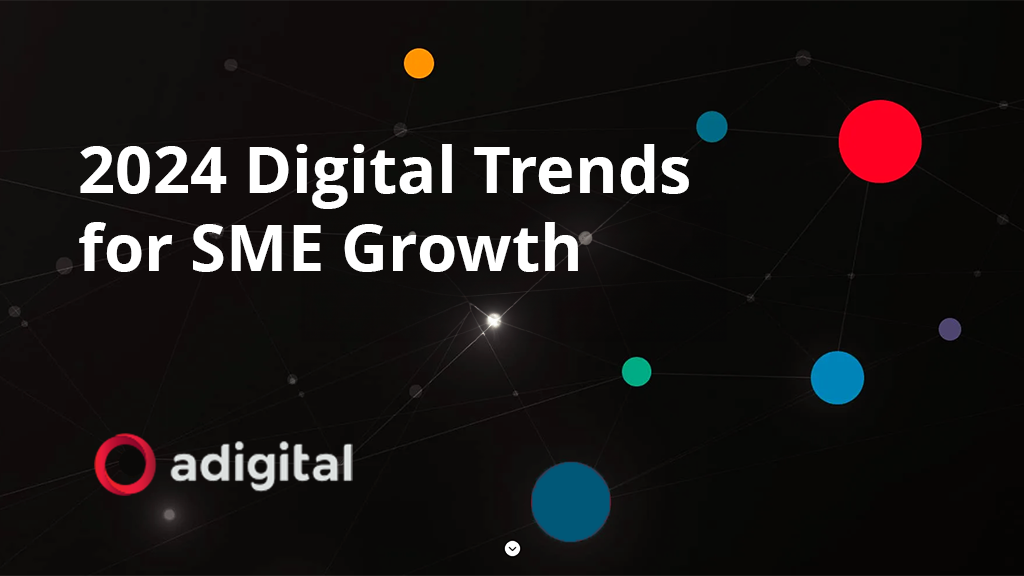
Adigital, the leading business association representing the Digital Economy in Spain has released a report entitled: ‘2024 Digital Trends for SME Growth.’ The report is a collaboration with members of the Adigital ecosystem of Associates, which explores the paths that will be decisive in promoting the digital transformation of small and medium-sized companies in 2024.
The report analyzes the key elements needed to enhance the digital strategy of SEMs, facilitating the adoption of data and emerging technologies, promoting e-commerce and the digitalization of the sales channel whilst improving the customer experience, optimizing marketing campaigns, social media presence, talent management and contributing to the greater inclusion of citizens.
As a member of Adigital, ExoClick has contributed to the report for the ‘Marketing and Publicity’ section with an article written by ExoClick’s COO Adrien Fonzé entitled ‘The growth of mobile video ad formats in the advertising industry.’ The article takes a deep dive into how video advertising targeted at mobile devices is a major industry shift in recent years. Showcasing business intelligence data taken from ExoClick’s own global ad network, we can see which video ad formats have shown the most growth across Tier 1, 2 and 3 countries. Additionally the article explains how technology, consumer smartphone adoption and market forces have enabled digital advertising businesses like ExoClick to develop the platform technologies needed to maximize opportunities for this growth market.
César Tello, Director General at Adigital commented, “At Adigital, we know that supporting the digitalization success of SMEs involves integrated elements of transformation. The purpose of this report is to generate expert knowledge with our Adigital Partners, to provide innovative and cutting-edge ideas that contribute to the scalability of companies.”
The report is available as a PDF download (in Spanish) from Adigital’s website here. Below is the English version of the article ExoClick contributed:
The growth of mobile video ad formats in the advertising industry
Video advertising has seen exponential growth in the online advertising industry, especially on mobile devices. If we look at the world’s biggest advertising market the USA, according to Statista, year on year growth in video advertising spend has tripled since 2018 ($23.68 billion) to 2023 ($76.96 billion). But it is the device type distribution that is really interesting, and shows that video advertising targeting mobile devices has increased by four times. From $12 billion back in 2018 to a massive $51.06 billion in 2023. Statista predicts that by 2027 this will have increased to $82.13 billion on mobile, which is 77.5% of total projected spend.
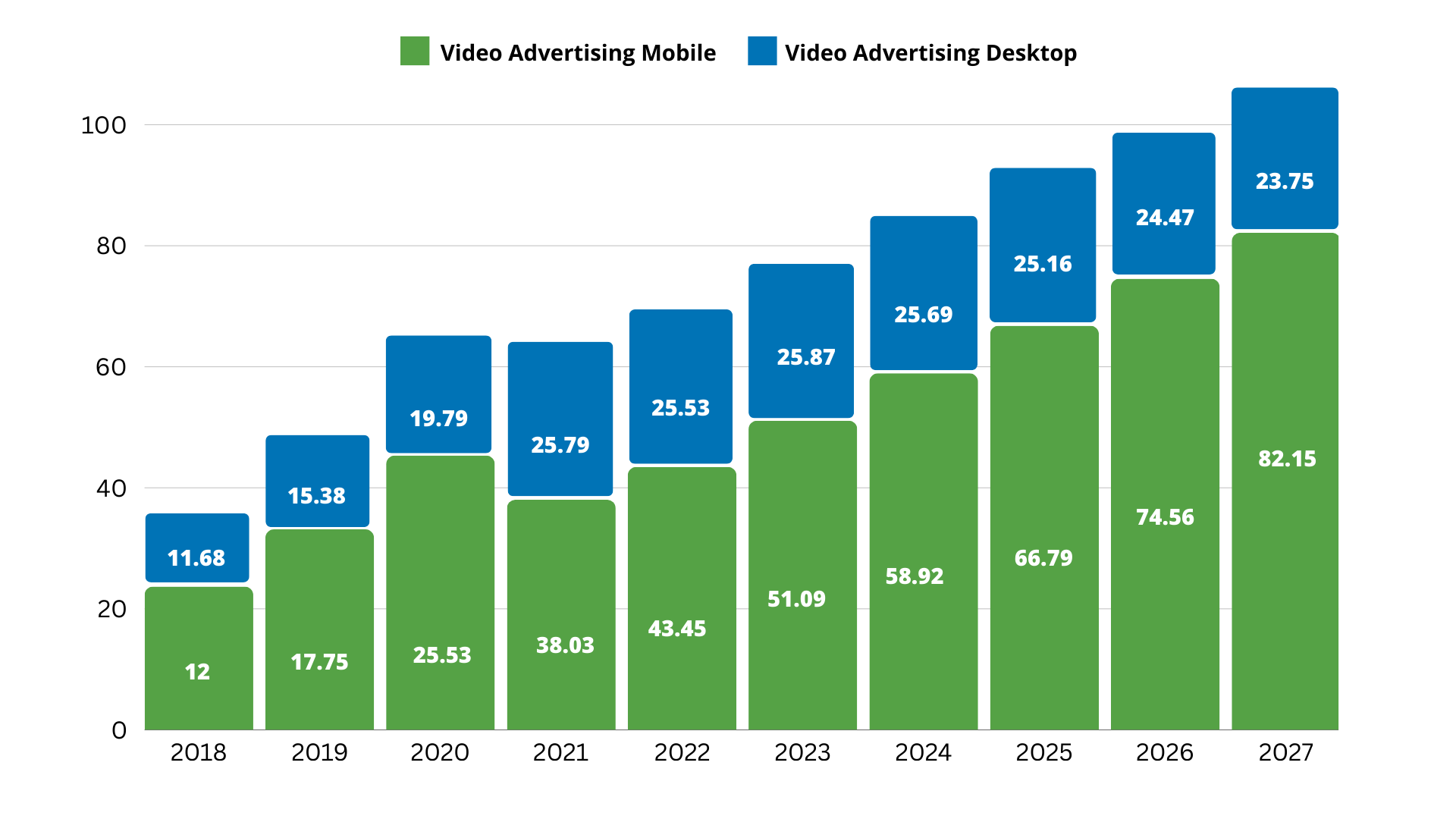
(Source: Statista)
Now let’s compare that to ad network ExoClick’s global data and we can find similar trends for video ad format impressions. Please note: the time of writing of this article is in Q4 2023, therefore ExoClick data insights are for a period of 24 months, from Q3 2021 until Q3 2023.
Comparing Q3 2021, 2022 and 2023: Mobile versus Desktop video ad impressions share
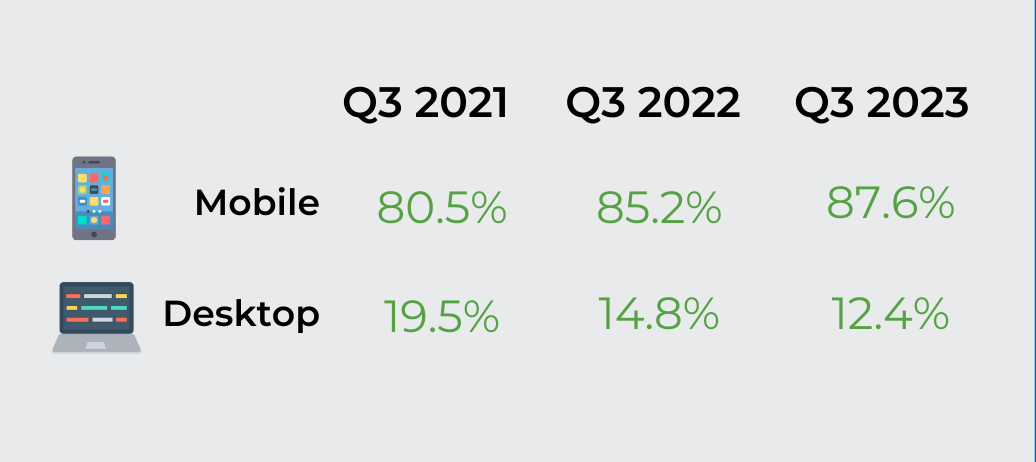
As we can see device split is also in favor of mobile and has increased by 7.1% comparing 2021 to 2023. Additionally, we saw a massive increase in volumes of mobile video ad impressions on the ExoClick network. For example, every second in Q3 2023 – 7,035 mobile web browsers saw a video ad served by ExoClick, compared to 4,333 in Q3 2022 and 2,661 in 2021.
What is fueling this exponential growth?
ExoClick identified 5 key factors contributing to the growth of mobile video ad formats in the advertising industry:
More video ad format options
As an ad network, ExoClick provides advertisers and publishers with 3 types of video ad formats that work on desktop and mobile devices and are fully compliant with Google and The Better Ads Coalition to ensure a great end user experience:
- In-stream plays before, during and after an end user watches a piece of video content on a website, just like Youtube. The format features a ‘skip ad’ button that the end user can click after 5 seconds.
- Outstream is positioned within the content of a publisher’s site. As the end user scrolls through the content, an Outstream video ad will open. To ensure a pleasant experience for the end user, the video ad automatically plays on mute, the end user can unmute, and the ad can be closed at any time by the viewer.
- Video Slider slides in from the bottom right of the websites page when an end user first visits a website. Again this ad can be closed by the end user and plays muted.
To monetize video content website publishers were limited to the In-stream video ad format, which requires a VAST compatible video player on the Publisher’s website in order to trigger, play and gather data on video ad performance. This alienated many websites that may have little or no video content on their websites. The Video Slider and Outstream video ad formats changed this. Both these video ad formats are served within their own video player so that the video ads can be served within these ad formats on websites. This opened up a larger market because even websites with just written articles or static image content could now monetize with video advertising. As you can see in the ExoClick network data below, comparing each year, all video ad formats have seen growth on mobile device impressions. Slider was really adopted by advertisers and publishers as a video ad format in 2023 and Outstream also saw increased demand in 2023 with +113.2%.
Comparing Q3 2021 to Q3 2022 and Q3 2023: Mobile video ad format impressions growth
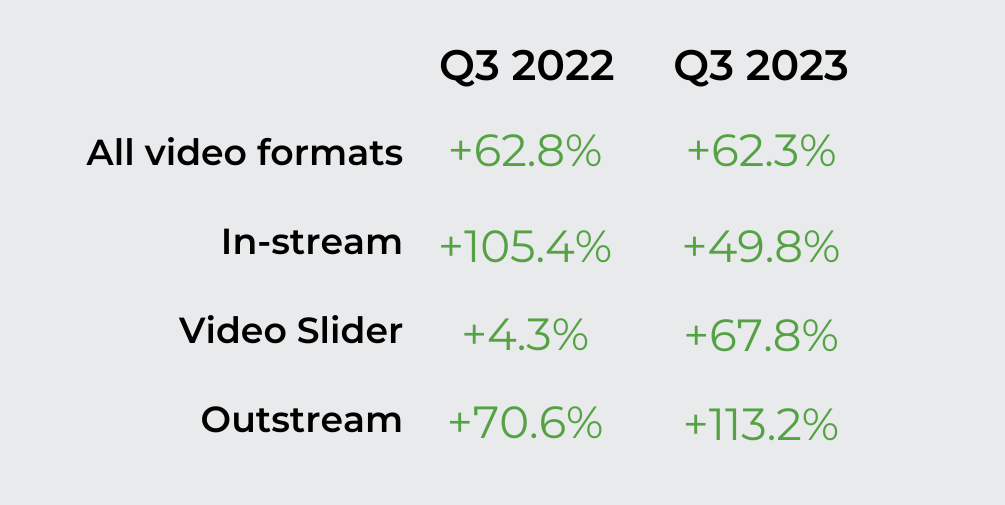
Video ad creation is easier
There is no need for a big film crew and professional camera gear. With the explosion of social media videos, consumers are happy to see video ads shot on a smartphone. AI technology has allowed mobile phone cameras to shoot amazing video, and that along with the many mobile video editing apps such as CapCut and Lumafusion coupled with platforms like Murf, where you can download AI generated voiceovers in several different languages. Now there is no barrier to creating quick video ads that are highly engaging for end consumers.
Advanced ad network platform features
Mobile advertising allows for highly specific targeting, such as targeting by specific mobile device, or operating system. Advertisers can leverage user data and preferences to tailor their video ads to the interests, demographics, and behaviors of individual users, increasing the likelihood of engagement. Ad platforms provide detailed analytics and metrics, which allow advertisers to track the performance of their video ads. They can measure views, click-through rates, conversions, and other key performance indicators, providing valuable insights for campaign optimization.
Smartphone device adoption
Smartphone adoption continues to increase and for less affluent Tier 2 & 3 countries, a smartphone can be the main device used to connect to the internet. For example if we look at India in 2022, 66.21% of the population had a smartphone, by 2023 this has increased to 70.95% and according to Statista by 2027 this will be 83.79% of the population. This brings more potential consumers on smartphones. As you can see below, from our network statistics, in Tier 3 countries 97.1% of video ads are currently targeting mobile devices and in Tier 2 countries 88.2%. Affluent Tier 1 countries are still seeing about a fifth of video ads being targeted at desktop, as these countries have the spending power for people to own multiple devices. But as you can see in the statistics below, mobile is now definitely ‘king’ across the world.
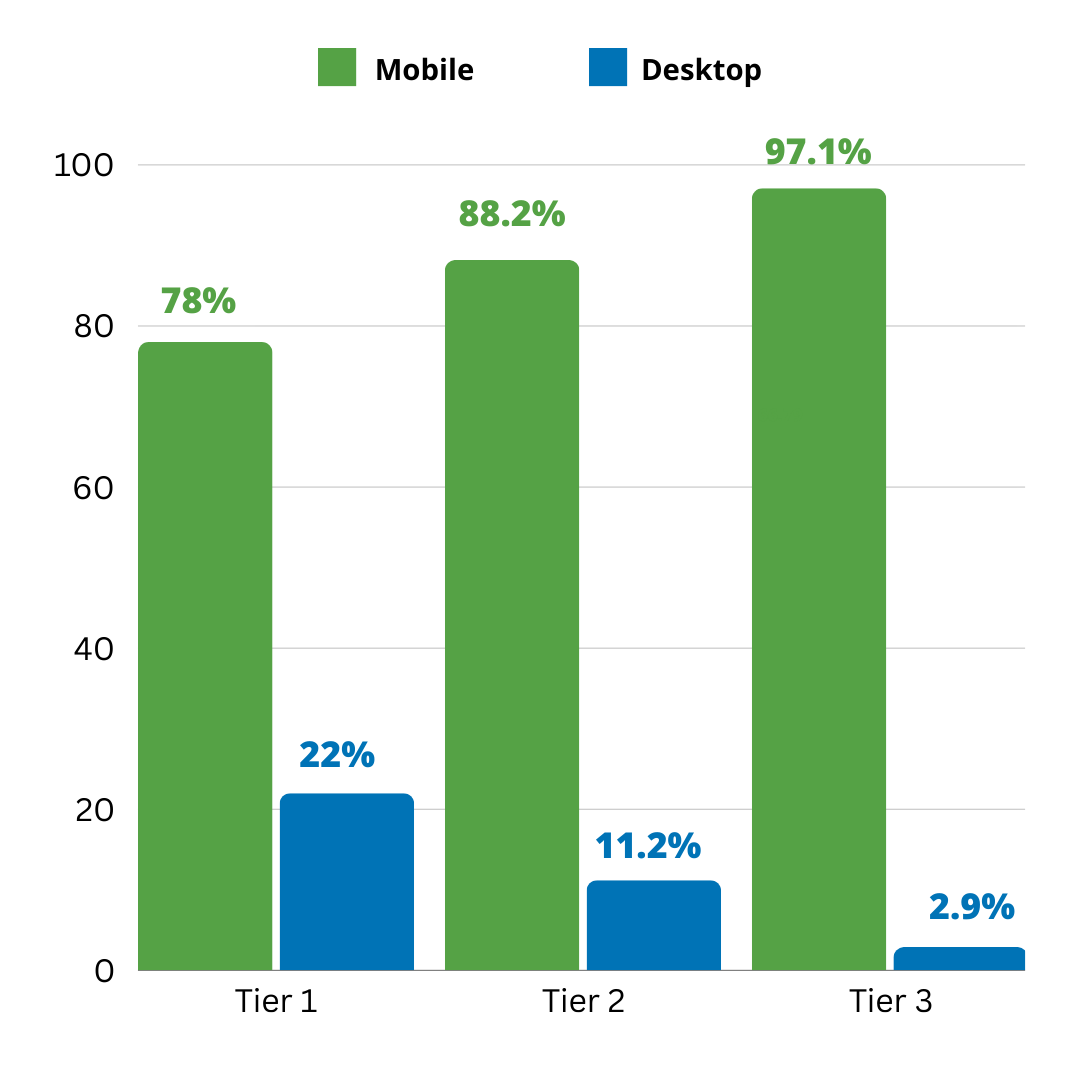
5G technology roll out
The rollout and adoption of 5G technology has significantly helped mobile video advertising. The faster data speeds of 5G networks ensures very low latency, and video ads can be delivered in higher-resolution without problems with buffering or slow load times, providing a better user experience. 5G’s improved accuracy in geolocation data allows for more precise location-based advertising. Advertisers can target users with highly relevant ads based on their specific location, which is valuable for businesses like retail stores, restaurants, and event promotions. With 5G, dynamic ad insertion in live streaming and video-on-demand becomes more efficient. Advertisers can serve personalized and targeted ads in real-time during live events or via streaming services, maximizing ad revenue and relevance.
The growth of mobile video ad formats in the advertising industry: Conclusion
Of all the ad formats on ExoClick’s network it is video that is showing the biggest incremental growth, especially the In-stream video format on Mobile devices. This is not surprising by the amount of long and short video content consumed on these devices globally. That matched with the high CTR that advertisers can expect with video ad formats has led to this growth. Now as 5G gets rolled out to more and more countries and device screens are getting bigger, we can expect to see video and mobile continue to advance into the leading pairing in the online advertising ecosystem for many years to come.
This is an English translation of the article ‘El crecimiento de los formatos de anuncios en vídeo para móviles en la industria publicitaria’, written by Adrien Fonzé, COO de ExoClick for Adigital’s report: Tendencias Digitales 2024 para el Crecimiento de la PYME.
About Adigital
Adigital represents over 525 innovative and transformative companies that believe in and work for the development of the economy based on the Internet, Digital Media and New Technologies. The organization brings together under the same umbrella large companies, SMEs and startups from very different sectors, united by a common goal: to create in Spain and Europe an optimal environment for the development and growth of the digital economy in order to achieve a more competitive, efficient and productive society.